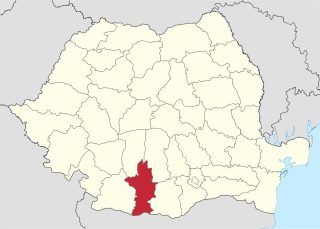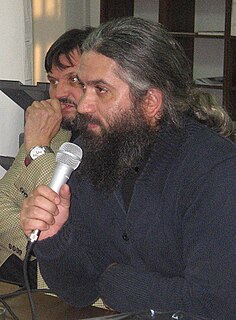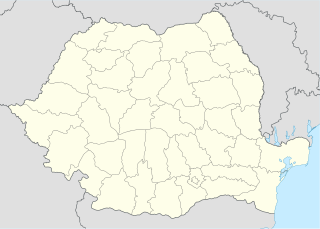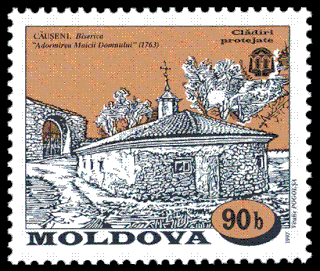
Moldova, officially the Republic of Moldova, is a landlocked country in Eastern Europe. It is bordered by Romania to the west and Ukraine to the north, east, and south. The capital city is Chișinău.

Romania is a country located at the crossroads of Central, Eastern, and Southeastern Europe. It borders with Bulgaria to the south, Ukraine to the north, Hungary to the west, Serbia to the southwest, and Moldova to the east and has its opening to the Black sea. It has a predominantly temperate-continental climate. With a total area of 238,397 square kilometres, Romania is the 12th-largest country in Europe and the 7th most populous member state of the European Union, having approximately 20 million inhabitants. Its capital and largest city is Bucharest. Other major urban areas include: Cluj-Napoca, Timișoara, Iași, Constanța, Craiova, Brașov, and Galați.

Romanian is a Balkan Romance language spoken by approximately 24–26 million people as a native language, primarily in Romania and Moldova, and by another 4 million people as a second language. According to another estimate, there are about 34 million people worldwide who can speak Romanian, out of which 30 million speak it as a native language. It is an official and national language of both Romania and Moldova and is one of the official languages of the European Union.

Bucharest is the capital and largest city of Romania, as well as its cultural, industrial, and financial centre. It is located in the southeast of the country, at 44°25′57″N26°06′14″E, on the banks of the Dâmbovița River, less than 60 km (37.3 mi) north of the Danube River and the Bulgarian border.

Nicolae Ceaușescu was a Romanian communist politician and leader. He was the general secretary of the Romanian Communist Party from 1965 to 1989 and hence the second and last Communist leader of Romania. He was also the country's head of state from 1967, serving as President of the State Council and from 1974 concurrently as President of the Republic until his overthrow and execution in the Romanian Revolution in December 1989, part of a series of anti-Communist and anti-Soviet Union uprisings in Eastern Europe that year.

Olt County is a county (județ) of Romania on the border with Bulgaria, in the historical regions of Oltenia and Muntenia. The capital city is Slatina.

Cavnic is a former mining town situated in the valley of the river Cavnic, 26 km (16 mi) east of Baia Mare, in Maramureș County, northern Romania. The town covers 47.17 km2 (18 sq mi), at altitudes ranging from 500 to 1050 meters above sea level.

The People's Salvation Cathedral also known as the National Cathedral is an Orthodox cathedral under construction in Bucharest that is meant to become the patriarchal cathedral of the Romanian Orthodox Church. It is the tallest and largest Orthodox church in the world by volume. It is the largest Eastern Orthodox church in the world by area, according to the full church criterion, and the second in the world including the partial church criterion, or the third in the world by area including the Oriental Orthodox church criterion. It is located in central Bucharest on Spirea's Hill, facing the same courtyard as the Palace of the Parliament the heaviest building in the world, the cathedral having the tenth part of its weight. The standard ground level of the People's Salvation Cathedral above the Black Sea is 86.2 meters. At 135 meters, the cathedral holds a dominant position in Bucharest's cityscape and is visible from all approaches to the city.

Elisabeta Rizea was a Romanian anti-communist partisan in the Făgăraș Mountains of Northern Wallachia. After the Romanian Revolution, she became the symbol of Romania's anti-communist resistance.
Ursoaia may refer to several villages in Romania:

Grădina Icoanei is a small park in central Bucharest, situated not far away from Piața Romană and Bulevardul Magheru. The park was inaugurated in 1873.
The Nemțișor is a left tributary of the river Neamț (Ozana) in Romania. It discharges into the Neamț in Vânători-Neamț. Its length is 25 km (16 mi) and its basin size is 88 km2 (34 sq mi).
The Plapcea is a right tributary of the river Vedea in Romania. It discharges into the Vedea in Icoana. The following towns and villages are situated along the river Plapcea, from source to mouth: Constantinești, Mogoșești, Jitaru, Potcoava, Fălcoeni, Sinești and Icoana. Its length is 56 km (35 mi) and its basin size is 354 km2 (137 sq mi).
Icoana may refer to the following places in Romania:

Ștefan Baștovoi, best known as Savatie Baștovoi is a Moldavian orthodox monk, is an essayist, poet, novelist, theologian and Romanian writer of the Republic of Moldova. He became a member of the Writers' Union of Moldova in 1996. He was also a moderator of a television show.

Ulmi is a commune located in Giurgiu County, Romania. It is composed of eight villages: Căscioarele, Drăgăneasca, Ghionea, Icoana, Moșteni, Poenari, Trestieni and Ulmi.

The Church of Assumption of Our Lady, Căuşeni is a historical monument in Căuşeni, Moldova.
Dumitru Theodor Neculuță was a Romanian poet.

The COVID-19 pandemic in Romania is part of the ongoing worldwide pandemic of coronavirus disease 2019 caused by severe acute respiratory syndrome coronavirus 2. The virus was confirmed to have reached Romania on 26 February 2020, when the first case in Gorj County was confirmed.
















